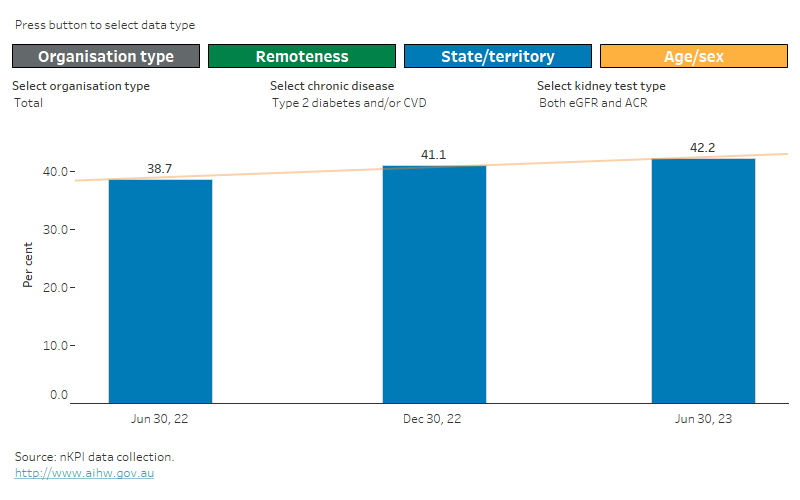Kidney function test – type 2 diabetes and/or CVD (PI18 and PI19)
Indicators related to kidney function tests in the national Key Performance Indicators (nKPI) collection are:
- Kidney function test type – type 2 diabetes and/or cardiovascular disease (CVD) (PI18): the proportion of First Nations regular clients aged 18 and over with type 2 diabetes and/or CVD who, within the previous 12 months, had:
- both an estimated glomerular filtration rate (eGFR) AND an albumin/creatinine ratio (ACR) test result recorded
- only an eGFR test result recorded
- only an ACR test result recorded
- neither an eGFR nor an ACR test result recorded.
- Kidney function test result (risk category) – type 2 diabetes and/or CVD (PI19): the proportion of First Nations regular clients aged 18 and over with type 2 diabetes and/or CVD who had both an eGFR and ACR test result recorded within the previous 12 months as either:
- normal risk
- low risk
- moderate risk
- high risk.
PI18 and PI19 are collected for males and females in age groups:
- 18–24
- 25–34
- 35–44
- 45–54
- 55–64
- 65 and over.
There have been changes to the specification of these indicators over time. For more information see Interpreting nKPI data.
Why testing kidney function is important
Type 2 diabetes and CVD can damage the kidneys. If kidney disease is diagnosed early, appropriate treatment can be given and its effects can be closely monitored.
The Royal Australian College of General Practitioners (RACGP) guidelines recommend screening kidney function annually for patients with type 2 diabetes and every 1 to 2 years for patients with CVD. This screening checks urine albumin/creatinine ratio (ACR) for albuminuria, and estimated glomerular filtration rate (eGFR) (Kidney Health Australia 2020, RACGP 2020).
Data reported in the Aboriginal and Torres Strait Islander Health Performance Framework show that First Nations people are far more likely to develop, and to die from, chronic kidney disease than non-Indigenous Australians (AIHW 2023).
Kidney function test type – type 2 diabetes and/or CVD (PI18)
At June 2023, both an eGFR and an ACR test result was recorded within the previous 12 months for:
- 45% (or around 22,300) of First Nations regular clients aged 18 and over with type 2 diabetes
- 39% (or around 7,700) of First Nations regular clients aged 18 and over with CVD
- 42% (or around 24,800) of First Nations regular clients aged 18 and over with type 2 diabetes and/or CVD (Figure 1).
Figure 1: Kidney function test type – type 2 diabetes and/or CVD – by reporting period and kidney test type
Kidney function test type – type 2 diabetes and/or CVD, by reporting period and kidney test type
This Tableau visualisation shows the percentage of First Nations regular clients aged 18 and over with type 2 diabetes and/or CVD who had a kidney function test recorded in the last year by test type (select for ACR, eGFR, both ACR and eGFR, or neither) and reporting period from June 2022 to June 2023 for either:
- organisation type (ACCHO, non-ACCHO)
- remoteness area (Major cities, Inner regional, Outer regional, Remote, Very remote)
- state/territory (NSW/ACT, Vic, Qld, WA, SA, Tas, NT)
- age/sex group (male, female with age group 18–34, 35–44, 45–54, 55–64, 65+).
Data supporting this visualisation are available in Excel supplementary data tables at Data.

Note: For more information, including on interpreting changes over time, see Technical notes.
Kidney function test result (risk category) – type 2 diabetes and/or CVD (PI19)
At June 2023, a risk category of ‘normal’ was recorded within the previous 12 months for:
- 39% (or around 8,500) of First Nations regular clients aged 18 and over with type 2 diabetes
- 41% (or around 3,100) of First Nations regular clients aged 18 and over with CVD
- 41% (or around 10,000) of First Nations regular clients aged 18 and over with type 2 diabetes and/or CVD (Figure 2).
Figure 2: Kidney function test result (risk category) – type 2 diabetes and/or CVD – by reporting period
Kidney function test result (risk category) – type 2 diabetes and/or CVD - by reporting period
This Tableau visualisation shows the percentage of First Nations regular clients aged 18 and over with type 2 diabetes and/or CVD who had both and ACR and eGFR test result to determine CKD risk category (select for normal, low, moderate or high) from June 2022 to June 2023 for either:
- organisation type (ACCHO, non-ACCHO)
- remoteness area (Major cities, Inner regional, Outer regional, Remote, Very remote)
- state/territory (NSW/ACT, Vic, Qld, WA, SA, Tas, NT)
- age/sex group (male, female with age group 18–34, 35–44, 45–54, 55–64, 65+).
Data supporting this visualisation are available in Excel supplementary data tables at Data.

Note: For more information, including on interpreting changes over time, see Technical notes.
For more information on kidney function test type see Data.
References
AIHW (Australian Institute of Health and Welfare) (2023) Aboriginal and Torres Strait Islander Health Performance Framework: kidney disease, AIHW, Australian Government, accessed 1 November 2023.
Kidney Health Australia (2020) Chronic Kidney Disease (CKD) Management in Primary Care (4th edition), Kidney Health Australia, accessed 11 December 2023.
RACGP (The Royal Australian College of General Practitioners) (2020) Management of type 2 diabetes: a handbook for general practice, RACGP, accessed 1 November 2023.


